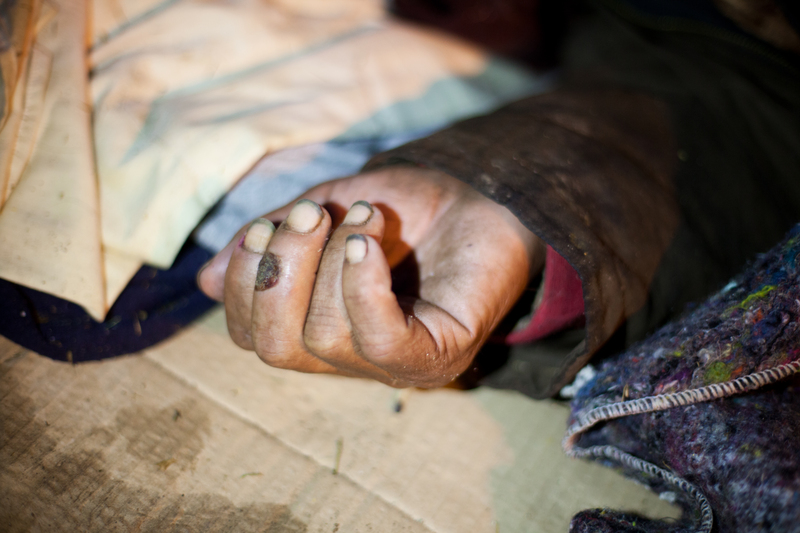
The hand of a homeless man who sleeps on the streets of Santiago, Chile. Can rights, courts, lawyers and activists actually make a difference on poverty?
Mahatma Gandhi called poverty the greatest form of violence. The global toll of avoidable, man-made poverty—thousands dead every day, billions sick and hungry—represents a blight on the human rights movement. Yet mainstream human rights have long turned a blind-eye to poverty, focusing instead on a small group of narrowly conceived civil and political rights, with marginal relevance to the poor. The irony is that human rights offer—in theory—such promise to the poor. Human rights comprise a unique universal framework, applying equally to all, covering all essential needs. With such broad and enduring hope in human rights, it is worth asking whether the tools of the movement—rights, courts, lawyers and activists—can actually make a difference on poverty.
When colleagues and I set out to build an economic and social rights (ESR) organization twenty years ago (the Center for Economic and Social Rights), we (and others) were pitching both a broader conception of rights and the need for new ways of working. Our concerns then—that traditional top down models of human rights work would fail to get traction on issues that challenged the reigning economic-political-legal order—anticipated the recent flurry of critiquesof mainstream “Human Rights” in these and other pages. We have long known that poverty is rooted in power; and yet, traditional power-blind approaches to poverty remain predominant.
We see this across various fields. The development community spends the bulk of its resources attending to short-term crises, and avoids systemic abuses. Legal services for the poor remain wed to individual service models. Mainstream human rights groups wade gingerly and apolitically into economic and social rights, focused only on egregious violations. There is no question that these interventions can bring benefits to poor people; but they won’t transform poverty. Worse, well-meaning advocates for the poor will often end up reinforcing a sense of victimhood and dependency, and legitimizing the broader system.
Legal and development communities have reacted to top down approaches by stressing the importance of empowering poor clients in the process of serving them. This has been described as “rebellious lawyering” or “community lawyering” by the US poverty law/progressive law crowd, and a “capabilities” or “human development” approach by development advocates. If not always the tools, the rhetoric of human rights is well suited to these ends, able to free “victims” from traditional constraining mindsets, to legitimize grievances and to help spark action.
But bottom up approaches raise various challenges for human rights advocates. They require great commitments in time and resources. They run up against traditional legal roles and training and egos. They can devolve into a level of micro-lawyering or advocacy that loses sight of the forest (larger institutional power dynamics) for the trees. They are particularly tricky for transnational human rights advocacy, practiced across borders with little connection to the actual “clients”.
At the other end of the spectrum lies what might be described as “cause lawyering” or “impact litigation”. Ralph Nader describes this as lawyering without clients, with “victims” selected and instrumentalized for the purpose of the larger legal end. Many human rights advocates would associate themselves with this approach. Rights advocates have trumpeted the “justiciability” of economic and social rights, winning precedent-setting cases in front of treaty bodies and national courts on issues of health, housing, welfare, land, and so on (ESCR-Net maintains a robust database of cases). These cases can serve both legal and organizing purposes—strengthening the legitimacy of fledgling rights, raising awareness, providing a focal point for mobilizations, and creating actual political/legal power (process rights), among other things.
Still, the jury is out on “cause lawyering”. Most judiciaries are not amenable to these cases, winning them requires enormous resources and legal compromise, and actual enforcement remains a significant challenge. The US experience with impact litigation offers some caution; after much study, a consensus has emerged that even iconic victories like Brown v Board of Education and Roe v Wade may do more long term damage than good by drawing energy, leaders and resources away from grassroots and political efforts, and sparking more powerful backlash. The initial reviews of ESR cases are similarly mixed.
Somewhere between these two approaches lies a sweet spot that uses rights language liberally, but legal approaches selectively; that embeds any legal actions within existing movements as instruments of empowerment, not ends; that deploys lawyers as both “legal technicians” and “activists”; that is capable of recognizing power dynamics reinforcing poverty at local, national and international levels and able to connect those dots.
All of which begs certain questions:
- Can resources be mobilized at scale to support human rights work that directly confronts poverty, inequities and vested interests? The longstanding bias of human rights funders against ESR continues to limit this work.
- Can lawyers and litigation be incorporated into grassroots struggles without co-opting them? The legal training, the proximity to power, the allure of lawsuits, the mythologies of legal expertise all conspire against good faith efforts of lawyers to serve rather than lead campaigns.
- Can transnational human rights advocates find a way to work closely and collaboratively enough with those living in poverty, while retaining a strategic focus on broader structural issues? The rise of stronger human rights groups in the global south, connected to social movements and networked to international platforms (with a helpful infusion from the Ford Foundation) represents a promising, if fragile, step in this direction.
Ultimately, the turn to rights, lawyers and courts raises the question of whether the system’s own tools can be deployed to change (rather than reinforce) that same system. Theorists will wax pessimistic, but practitioners don’t have that luxury—we need these tools and have to find ways to make them work.
